Sustainable Supply Chain & Operation Efficiency in UAE Construction
VerifiedAdded on 2023/04/06
|15
|3047
|431
Report
AI Summary
This report investigates the impact of Green Supply Chain Management (GSCM) on operational efficiency and organizational performance within the construction industry of the United Arab Emirates (UAE). It highlights the increasing importance of sustainability in supply chain management due to growing environmental concerns and governmental regulations. The research explores the theoretical background of SCM, SSCM, and GSCM, discussing relevant theories such as complexity theory, information theory, and resource dependence theory. It also addresses the challenges and opportunities of integrating GSCM in the UAE construction sector, emphasizing the need for effective communication and collaboration among supply chain partners to achieve sustainability goals and improve organizational performance. The report further touches upon the role of new technologies and the potential for increased profitability and competitive advantage through GSCM implementation, despite initial costs associated with environmental management.
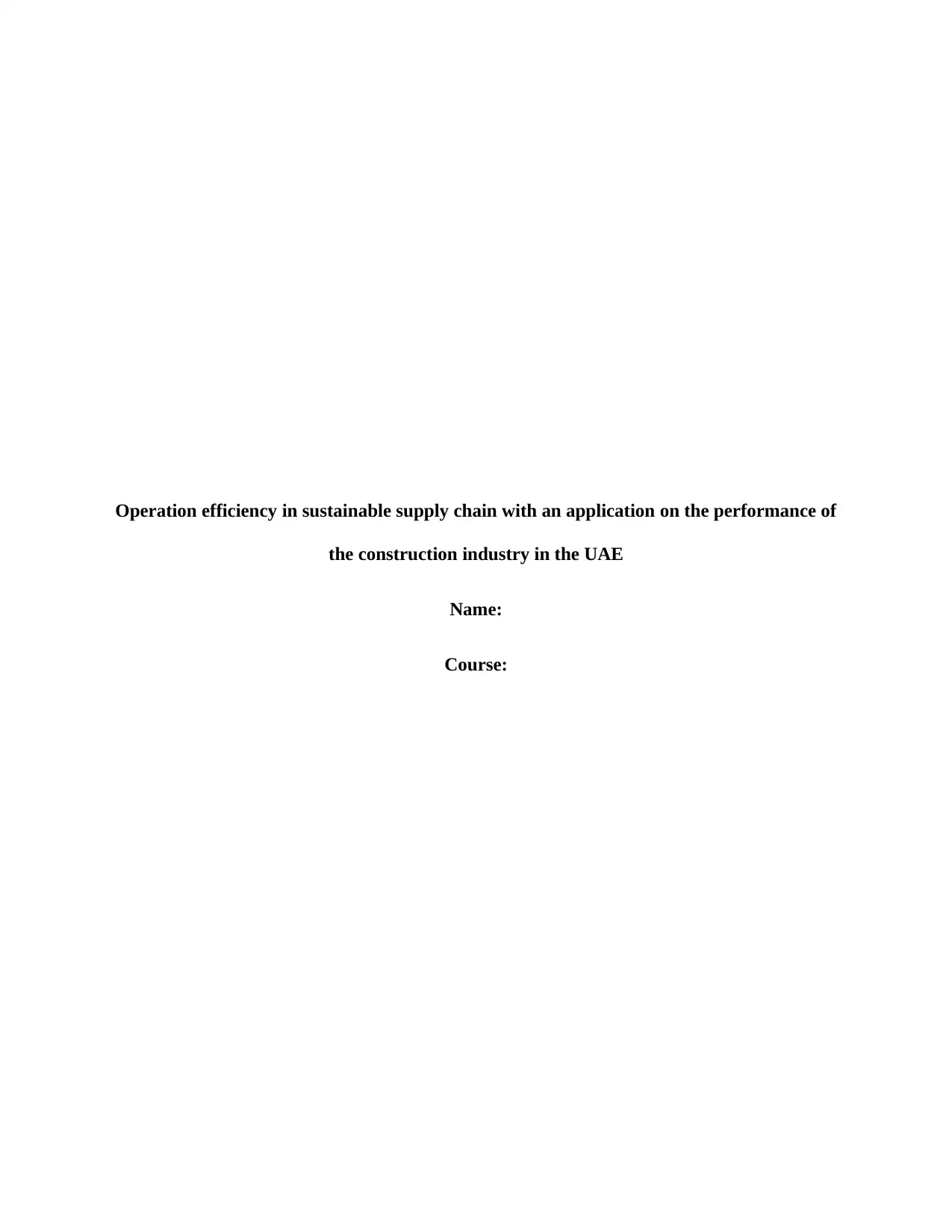
Operation efficiency in sustainable supply chain with an application on the performance of
the construction industry in the UAE
Name:
Course:
the construction industry in the UAE
Name:
Course:
Paraphrase This Document
Need a fresh take? Get an instant paraphrase of this document with our AI Paraphraser
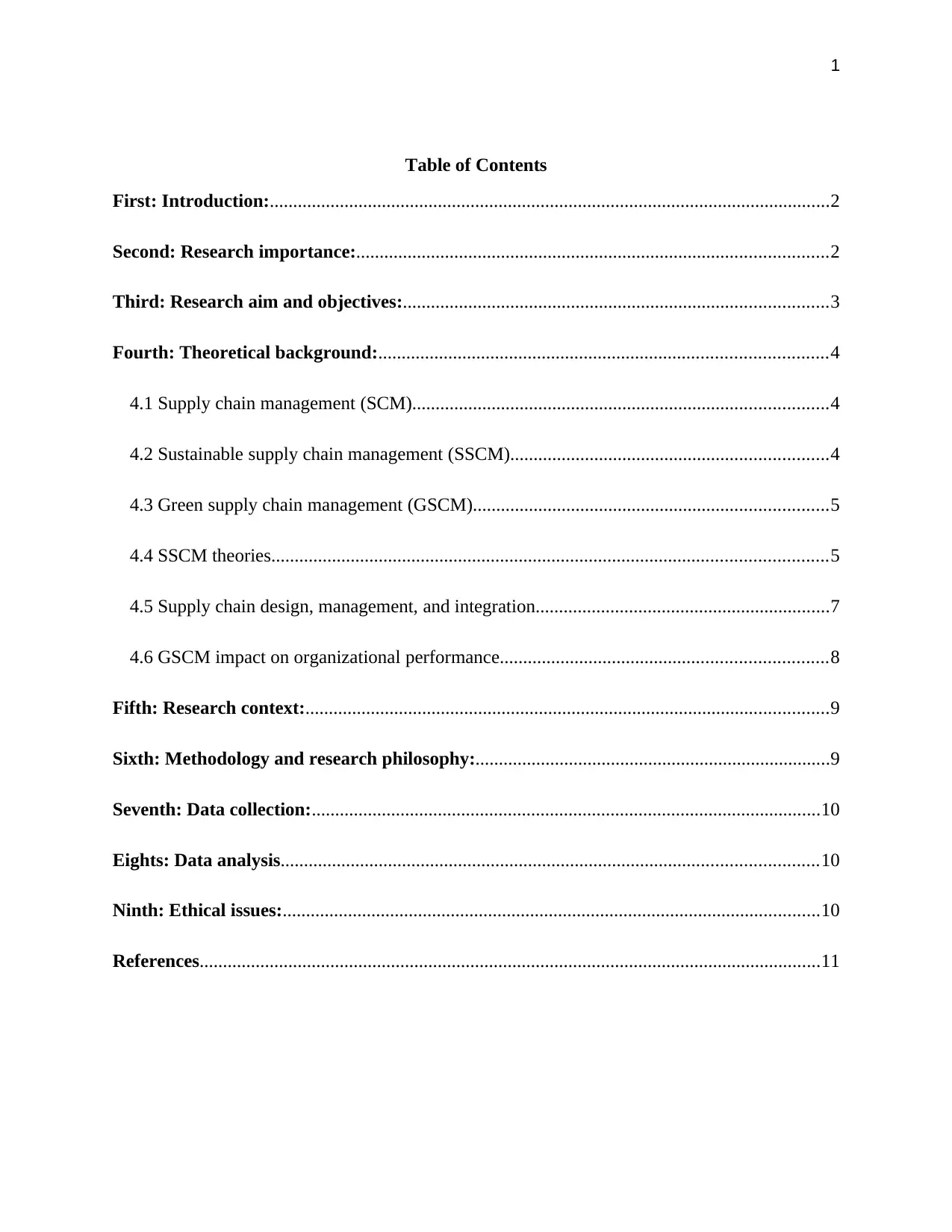
1
Table of Contents
First: Introduction:........................................................................................................................2
Second: Research importance:.....................................................................................................2
Third: Research aim and objectives:...........................................................................................3
Fourth: Theoretical background:................................................................................................4
4.1 Supply chain management (SCM).........................................................................................4
4.2 Sustainable supply chain management (SSCM)....................................................................4
4.3 Green supply chain management (GSCM)............................................................................5
4.4 SSCM theories.......................................................................................................................5
4.5 Supply chain design, management, and integration...............................................................7
4.6 GSCM impact on organizational performance......................................................................8
Fifth: Research context:................................................................................................................9
Sixth: Methodology and research philosophy:............................................................................9
Seventh: Data collection:.............................................................................................................10
Eights: Data analysis...................................................................................................................10
Ninth: Ethical issues:...................................................................................................................10
References.....................................................................................................................................11
Table of Contents
First: Introduction:........................................................................................................................2
Second: Research importance:.....................................................................................................2
Third: Research aim and objectives:...........................................................................................3
Fourth: Theoretical background:................................................................................................4
4.1 Supply chain management (SCM).........................................................................................4
4.2 Sustainable supply chain management (SSCM)....................................................................4
4.3 Green supply chain management (GSCM)............................................................................5
4.4 SSCM theories.......................................................................................................................5
4.5 Supply chain design, management, and integration...............................................................7
4.6 GSCM impact on organizational performance......................................................................8
Fifth: Research context:................................................................................................................9
Sixth: Methodology and research philosophy:............................................................................9
Seventh: Data collection:.............................................................................................................10
Eights: Data analysis...................................................................................................................10
Ninth: Ethical issues:...................................................................................................................10
References.....................................................................................................................................11
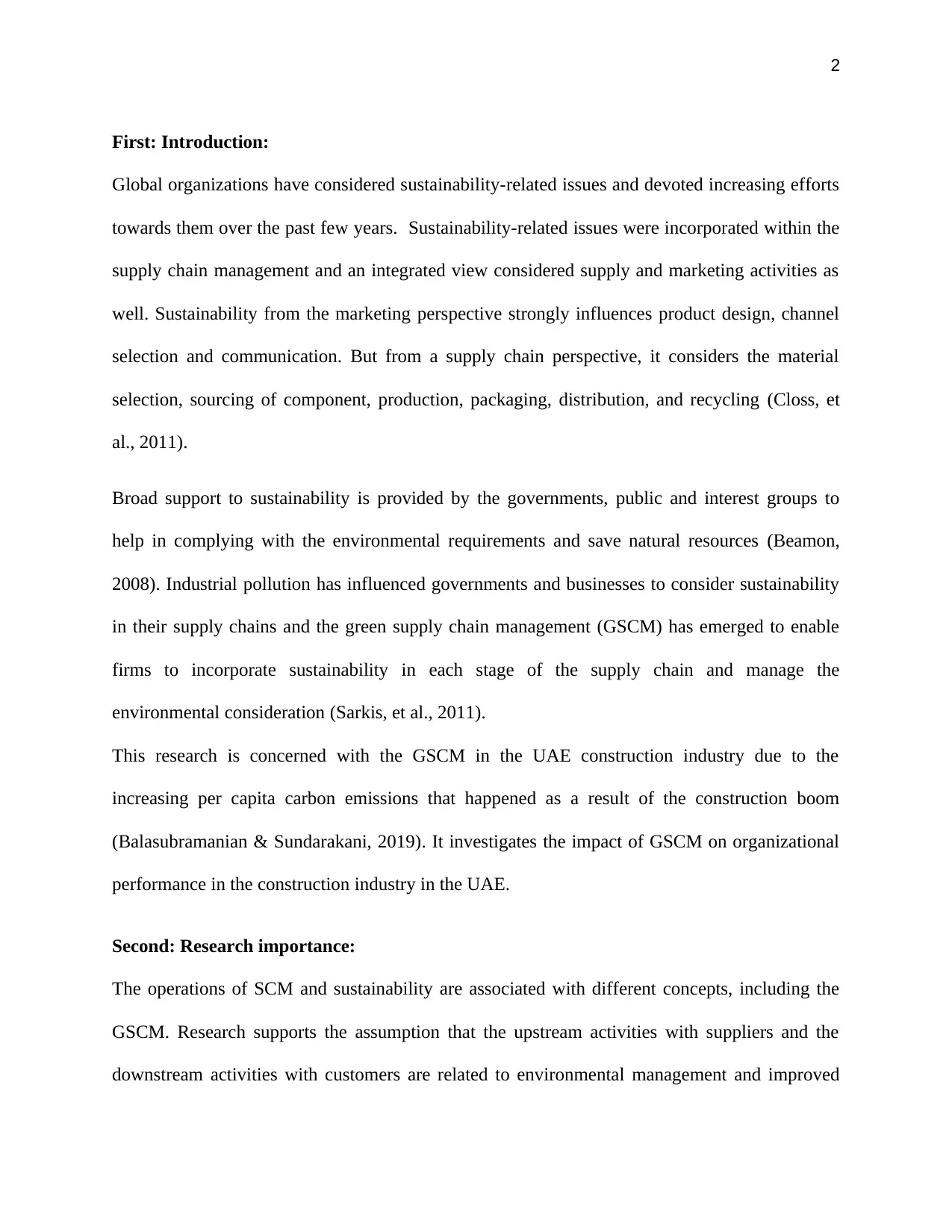
2
First: Introduction:
Global organizations have considered sustainability-related issues and devoted increasing efforts
towards them over the past few years. Sustainability-related issues were incorporated within the
supply chain management and an integrated view considered supply and marketing activities as
well. Sustainability from the marketing perspective strongly influences product design, channel
selection and communication. But from a supply chain perspective, it considers the material
selection, sourcing of component, production, packaging, distribution, and recycling (Closs, et
al., 2011).
Broad support to sustainability is provided by the governments, public and interest groups to
help in complying with the environmental requirements and save natural resources (Beamon,
2008). Industrial pollution has influenced governments and businesses to consider sustainability
in their supply chains and the green supply chain management (GSCM) has emerged to enable
firms to incorporate sustainability in each stage of the supply chain and manage the
environmental consideration (Sarkis, et al., 2011).
This research is concerned with the GSCM in the UAE construction industry due to the
increasing per capita carbon emissions that happened as a result of the construction boom
(Balasubramanian & Sundarakani, 2019). It investigates the impact of GSCM on organizational
performance in the construction industry in the UAE.
Second: Research importance:
The operations of SCM and sustainability are associated with different concepts, including the
GSCM. Research supports the assumption that the upstream activities with suppliers and the
downstream activities with customers are related to environmental management and improved
First: Introduction:
Global organizations have considered sustainability-related issues and devoted increasing efforts
towards them over the past few years. Sustainability-related issues were incorporated within the
supply chain management and an integrated view considered supply and marketing activities as
well. Sustainability from the marketing perspective strongly influences product design, channel
selection and communication. But from a supply chain perspective, it considers the material
selection, sourcing of component, production, packaging, distribution, and recycling (Closs, et
al., 2011).
Broad support to sustainability is provided by the governments, public and interest groups to
help in complying with the environmental requirements and save natural resources (Beamon,
2008). Industrial pollution has influenced governments and businesses to consider sustainability
in their supply chains and the green supply chain management (GSCM) has emerged to enable
firms to incorporate sustainability in each stage of the supply chain and manage the
environmental consideration (Sarkis, et al., 2011).
This research is concerned with the GSCM in the UAE construction industry due to the
increasing per capita carbon emissions that happened as a result of the construction boom
(Balasubramanian & Sundarakani, 2019). It investigates the impact of GSCM on organizational
performance in the construction industry in the UAE.
Second: Research importance:
The operations of SCM and sustainability are associated with different concepts, including the
GSCM. Research supports the assumption that the upstream activities with suppliers and the
downstream activities with customers are related to environmental management and improved
⊘ This is a preview!⊘
Do you want full access?
Subscribe today to unlock all pages.

Trusted by 1+ million students worldwide
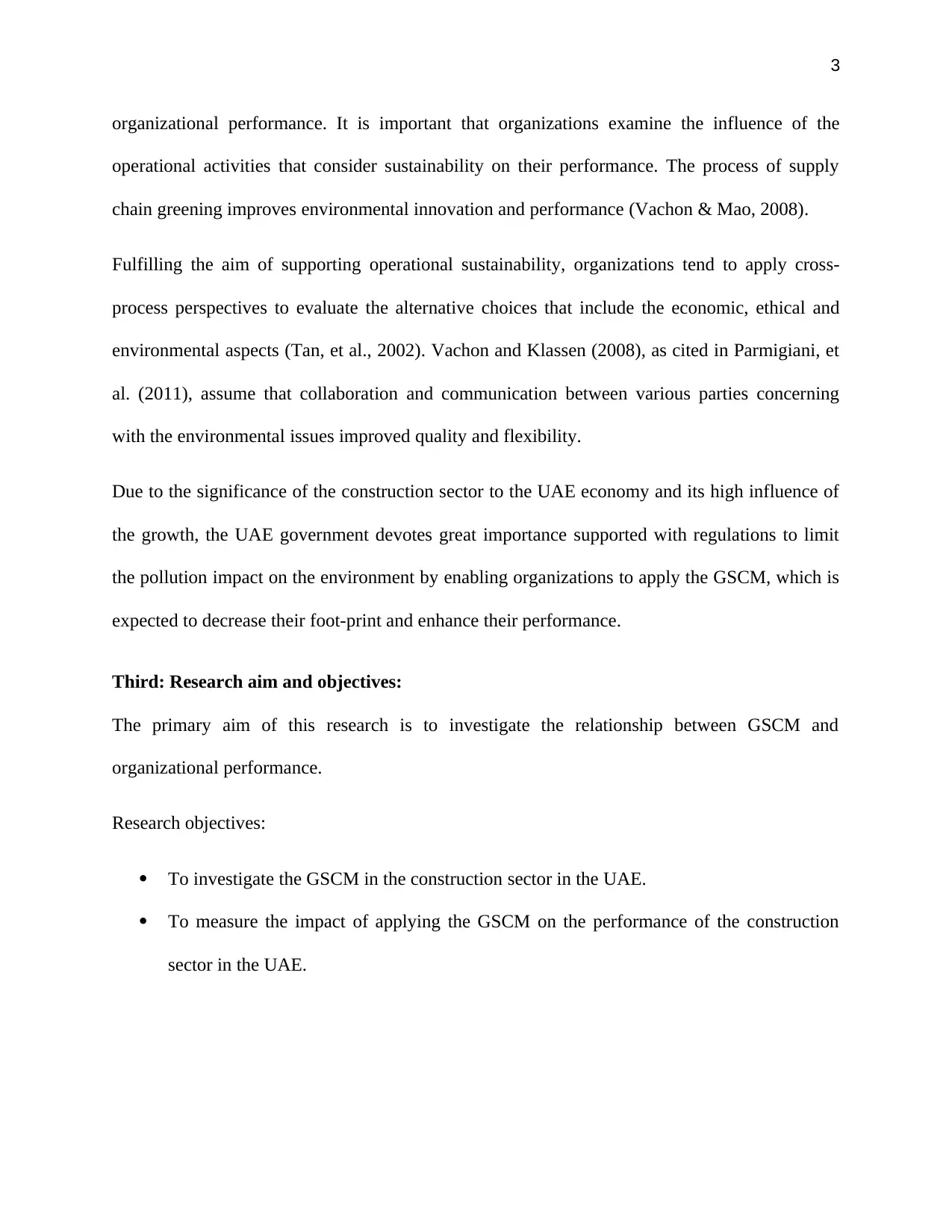
3
organizational performance. It is important that organizations examine the influence of the
operational activities that consider sustainability on their performance. The process of supply
chain greening improves environmental innovation and performance (Vachon & Mao, 2008).
Fulfilling the aim of supporting operational sustainability, organizations tend to apply cross-
process perspectives to evaluate the alternative choices that include the economic, ethical and
environmental aspects (Tan, et al., 2002). Vachon and Klassen (2008), as cited in Parmigiani, et
al. (2011), assume that collaboration and communication between various parties concerning
with the environmental issues improved quality and flexibility.
Due to the significance of the construction sector to the UAE economy and its high influence of
the growth, the UAE government devotes great importance supported with regulations to limit
the pollution impact on the environment by enabling organizations to apply the GSCM, which is
expected to decrease their foot-print and enhance their performance.
Third: Research aim and objectives:
The primary aim of this research is to investigate the relationship between GSCM and
organizational performance.
Research objectives:
To investigate the GSCM in the construction sector in the UAE.
To measure the impact of applying the GSCM on the performance of the construction
sector in the UAE.
organizational performance. It is important that organizations examine the influence of the
operational activities that consider sustainability on their performance. The process of supply
chain greening improves environmental innovation and performance (Vachon & Mao, 2008).
Fulfilling the aim of supporting operational sustainability, organizations tend to apply cross-
process perspectives to evaluate the alternative choices that include the economic, ethical and
environmental aspects (Tan, et al., 2002). Vachon and Klassen (2008), as cited in Parmigiani, et
al. (2011), assume that collaboration and communication between various parties concerning
with the environmental issues improved quality and flexibility.
Due to the significance of the construction sector to the UAE economy and its high influence of
the growth, the UAE government devotes great importance supported with regulations to limit
the pollution impact on the environment by enabling organizations to apply the GSCM, which is
expected to decrease their foot-print and enhance their performance.
Third: Research aim and objectives:
The primary aim of this research is to investigate the relationship between GSCM and
organizational performance.
Research objectives:
To investigate the GSCM in the construction sector in the UAE.
To measure the impact of applying the GSCM on the performance of the construction
sector in the UAE.
Paraphrase This Document
Need a fresh take? Get an instant paraphrase of this document with our AI Paraphraser
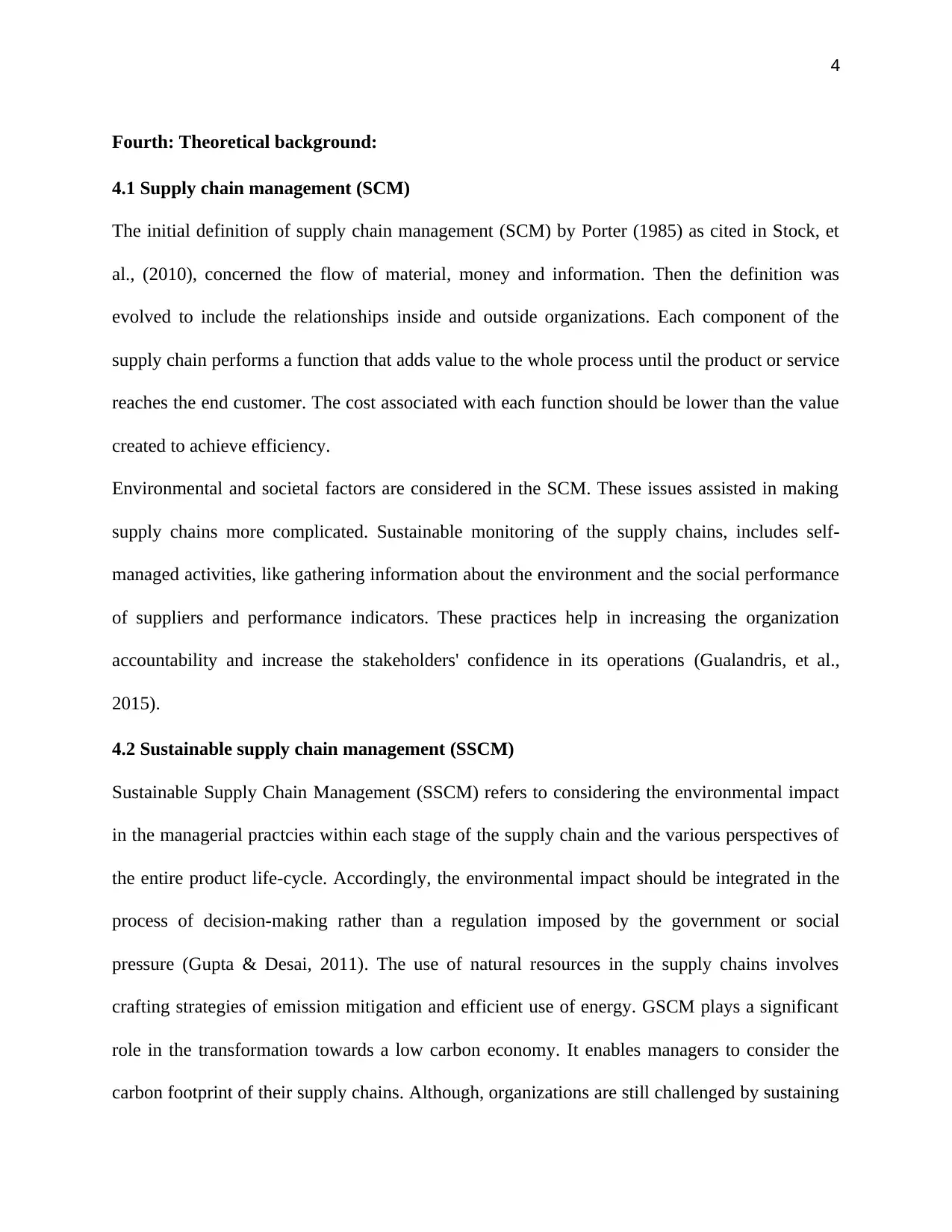
4
Fourth: Theoretical background:
4.1 Supply chain management (SCM)
The initial definition of supply chain management (SCM) by Porter (1985) as cited in Stock, et
al., (2010), concerned the flow of material, money and information. Then the definition was
evolved to include the relationships inside and outside organizations. Each component of the
supply chain performs a function that adds value to the whole process until the product or service
reaches the end customer. The cost associated with each function should be lower than the value
created to achieve efficiency.
Environmental and societal factors are considered in the SCM. These issues assisted in making
supply chains more complicated. Sustainable monitoring of the supply chains, includes self-
managed activities, like gathering information about the environment and the social performance
of suppliers and performance indicators. These practices help in increasing the organization
accountability and increase the stakeholders' confidence in its operations (Gualandris, et al.,
2015).
4.2 Sustainable supply chain management (SSCM)
Sustainable Supply Chain Management (SSCM) refers to considering the environmental impact
in the managerial practcies within each stage of the supply chain and the various perspectives of
the entire product life-cycle. Accordingly, the environmental impact should be integrated in the
process of decision-making rather than a regulation imposed by the government or social
pressure (Gupta & Desai, 2011). The use of natural resources in the supply chains involves
crafting strategies of emission mitigation and efficient use of energy. GSCM plays a significant
role in the transformation towards a low carbon economy. It enables managers to consider the
carbon footprint of their supply chains. Although, organizations are still challenged by sustaining
Fourth: Theoretical background:
4.1 Supply chain management (SCM)
The initial definition of supply chain management (SCM) by Porter (1985) as cited in Stock, et
al., (2010), concerned the flow of material, money and information. Then the definition was
evolved to include the relationships inside and outside organizations. Each component of the
supply chain performs a function that adds value to the whole process until the product or service
reaches the end customer. The cost associated with each function should be lower than the value
created to achieve efficiency.
Environmental and societal factors are considered in the SCM. These issues assisted in making
supply chains more complicated. Sustainable monitoring of the supply chains, includes self-
managed activities, like gathering information about the environment and the social performance
of suppliers and performance indicators. These practices help in increasing the organization
accountability and increase the stakeholders' confidence in its operations (Gualandris, et al.,
2015).
4.2 Sustainable supply chain management (SSCM)
Sustainable Supply Chain Management (SSCM) refers to considering the environmental impact
in the managerial practcies within each stage of the supply chain and the various perspectives of
the entire product life-cycle. Accordingly, the environmental impact should be integrated in the
process of decision-making rather than a regulation imposed by the government or social
pressure (Gupta & Desai, 2011). The use of natural resources in the supply chains involves
crafting strategies of emission mitigation and efficient use of energy. GSCM plays a significant
role in the transformation towards a low carbon economy. It enables managers to consider the
carbon footprint of their supply chains. Although, organizations are still challenged by sustaining
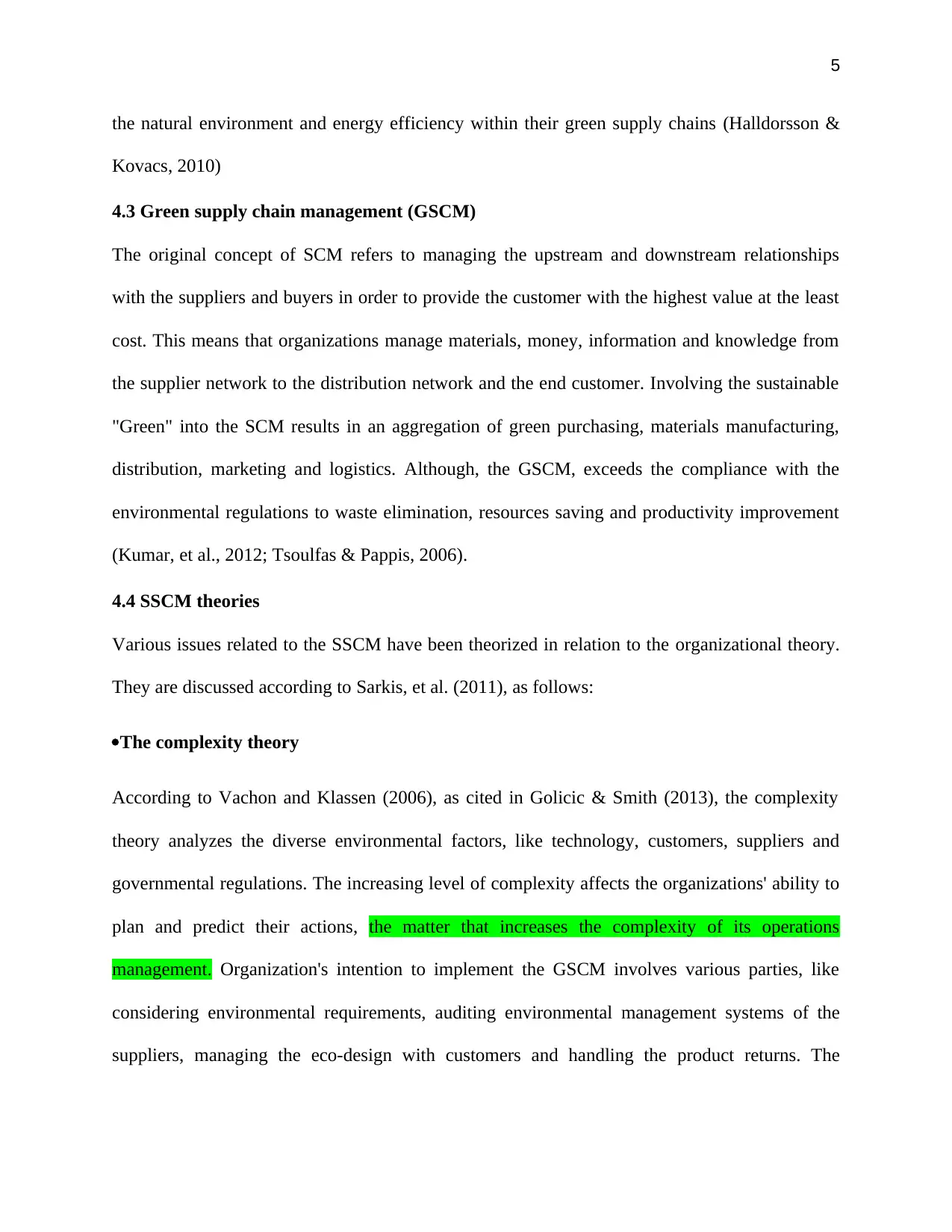
5
the natural environment and energy efficiency within their green supply chains (Halldorsson &
Kovacs, 2010)
4.3 Green supply chain management (GSCM)
The original concept of SCM refers to managing the upstream and downstream relationships
with the suppliers and buyers in order to provide the customer with the highest value at the least
cost. This means that organizations manage materials, money, information and knowledge from
the supplier network to the distribution network and the end customer. Involving the sustainable
"Green" into the SCM results in an aggregation of green purchasing, materials manufacturing,
distribution, marketing and logistics. Although, the GSCM, exceeds the compliance with the
environmental regulations to waste elimination, resources saving and productivity improvement
(Kumar, et al., 2012; Tsoulfas & Pappis, 2006).
4.4 SSCM theories
Various issues related to the SSCM have been theorized in relation to the organizational theory.
They are discussed according to Sarkis, et al. (2011), as follows:
The complexity theory
According to Vachon and Klassen (2006), as cited in Golicic & Smith (2013), the complexity
theory analyzes the diverse environmental factors, like technology, customers, suppliers and
governmental regulations. The increasing level of complexity affects the organizations' ability to
plan and predict their actions, the matter that increases the complexity of its operations
management. Organization's intention to implement the GSCM involves various parties, like
considering environmental requirements, auditing environmental management systems of the
suppliers, managing the eco-design with customers and handling the product returns. The
the natural environment and energy efficiency within their green supply chains (Halldorsson &
Kovacs, 2010)
4.3 Green supply chain management (GSCM)
The original concept of SCM refers to managing the upstream and downstream relationships
with the suppliers and buyers in order to provide the customer with the highest value at the least
cost. This means that organizations manage materials, money, information and knowledge from
the supplier network to the distribution network and the end customer. Involving the sustainable
"Green" into the SCM results in an aggregation of green purchasing, materials manufacturing,
distribution, marketing and logistics. Although, the GSCM, exceeds the compliance with the
environmental regulations to waste elimination, resources saving and productivity improvement
(Kumar, et al., 2012; Tsoulfas & Pappis, 2006).
4.4 SSCM theories
Various issues related to the SSCM have been theorized in relation to the organizational theory.
They are discussed according to Sarkis, et al. (2011), as follows:
The complexity theory
According to Vachon and Klassen (2006), as cited in Golicic & Smith (2013), the complexity
theory analyzes the diverse environmental factors, like technology, customers, suppliers and
governmental regulations. The increasing level of complexity affects the organizations' ability to
plan and predict their actions, the matter that increases the complexity of its operations
management. Organization's intention to implement the GSCM involves various parties, like
considering environmental requirements, auditing environmental management systems of the
suppliers, managing the eco-design with customers and handling the product returns. The
⊘ This is a preview!⊘
Do you want full access?
Subscribe today to unlock all pages.

Trusted by 1+ million students worldwide
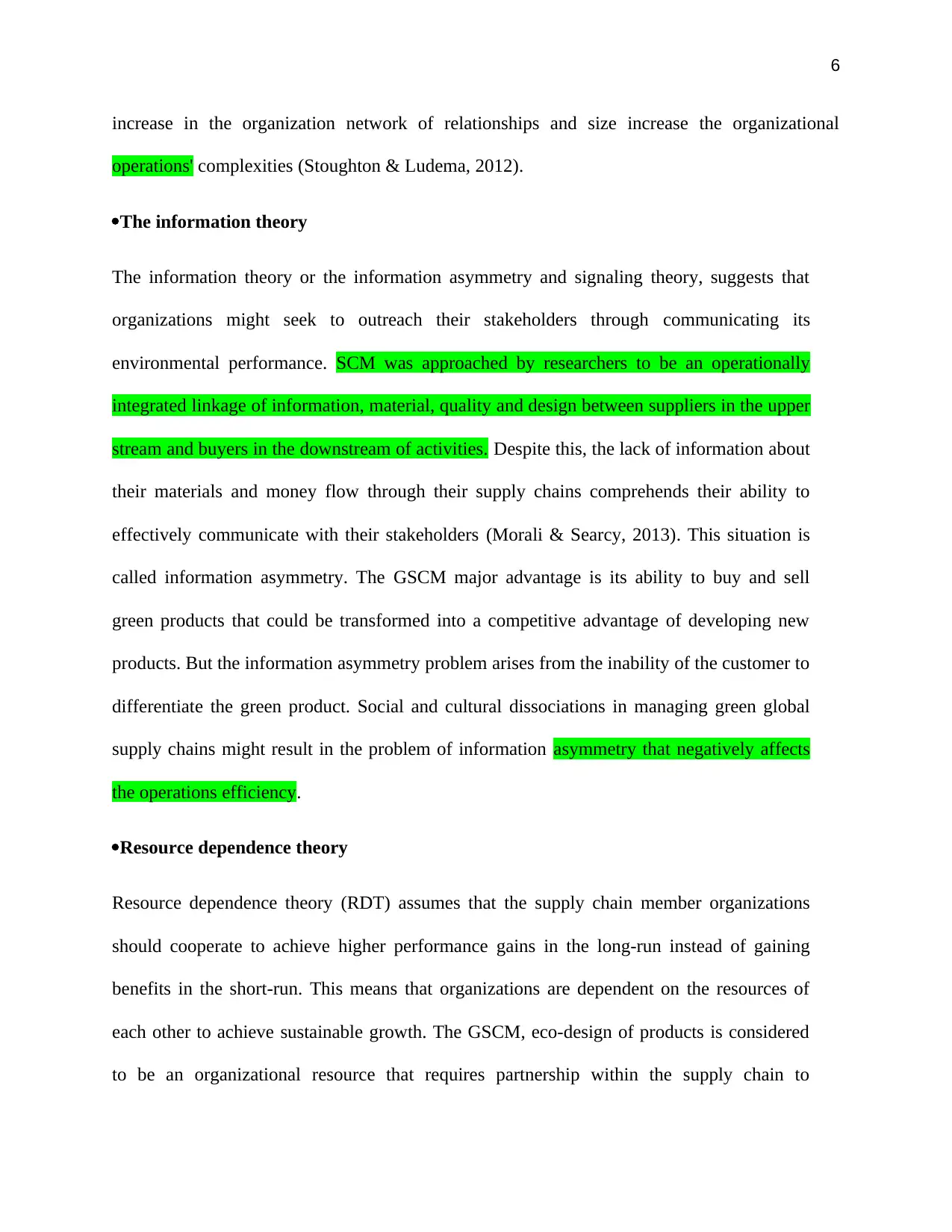
6
increase in the organization network of relationships and size increase the organizational
operations' complexities (Stoughton & Ludema, 2012).
The information theory
The information theory or the information asymmetry and signaling theory, suggests that
organizations might seek to outreach their stakeholders through communicating its
environmental performance. SCM was approached by researchers to be an operationally
integrated linkage of information, material, quality and design between suppliers in the upper
stream and buyers in the downstream of activities. Despite this, the lack of information about
their materials and money flow through their supply chains comprehends their ability to
effectively communicate with their stakeholders (Morali & Searcy, 2013). This situation is
called information asymmetry. The GSCM major advantage is its ability to buy and sell
green products that could be transformed into a competitive advantage of developing new
products. But the information asymmetry problem arises from the inability of the customer to
differentiate the green product. Social and cultural dissociations in managing green global
supply chains might result in the problem of information asymmetry that negatively affects
the operations efficiency.
Resource dependence theory
Resource dependence theory (RDT) assumes that the supply chain member organizations
should cooperate to achieve higher performance gains in the long-run instead of gaining
benefits in the short-run. This means that organizations are dependent on the resources of
each other to achieve sustainable growth. The GSCM, eco-design of products is considered
to be an organizational resource that requires partnership within the supply chain to
increase in the organization network of relationships and size increase the organizational
operations' complexities (Stoughton & Ludema, 2012).
The information theory
The information theory or the information asymmetry and signaling theory, suggests that
organizations might seek to outreach their stakeholders through communicating its
environmental performance. SCM was approached by researchers to be an operationally
integrated linkage of information, material, quality and design between suppliers in the upper
stream and buyers in the downstream of activities. Despite this, the lack of information about
their materials and money flow through their supply chains comprehends their ability to
effectively communicate with their stakeholders (Morali & Searcy, 2013). This situation is
called information asymmetry. The GSCM major advantage is its ability to buy and sell
green products that could be transformed into a competitive advantage of developing new
products. But the information asymmetry problem arises from the inability of the customer to
differentiate the green product. Social and cultural dissociations in managing green global
supply chains might result in the problem of information asymmetry that negatively affects
the operations efficiency.
Resource dependence theory
Resource dependence theory (RDT) assumes that the supply chain member organizations
should cooperate to achieve higher performance gains in the long-run instead of gaining
benefits in the short-run. This means that organizations are dependent on the resources of
each other to achieve sustainable growth. The GSCM, eco-design of products is considered
to be an organizational resource that requires partnership within the supply chain to
Paraphrase This Document
Need a fresh take? Get an instant paraphrase of this document with our AI Paraphraser
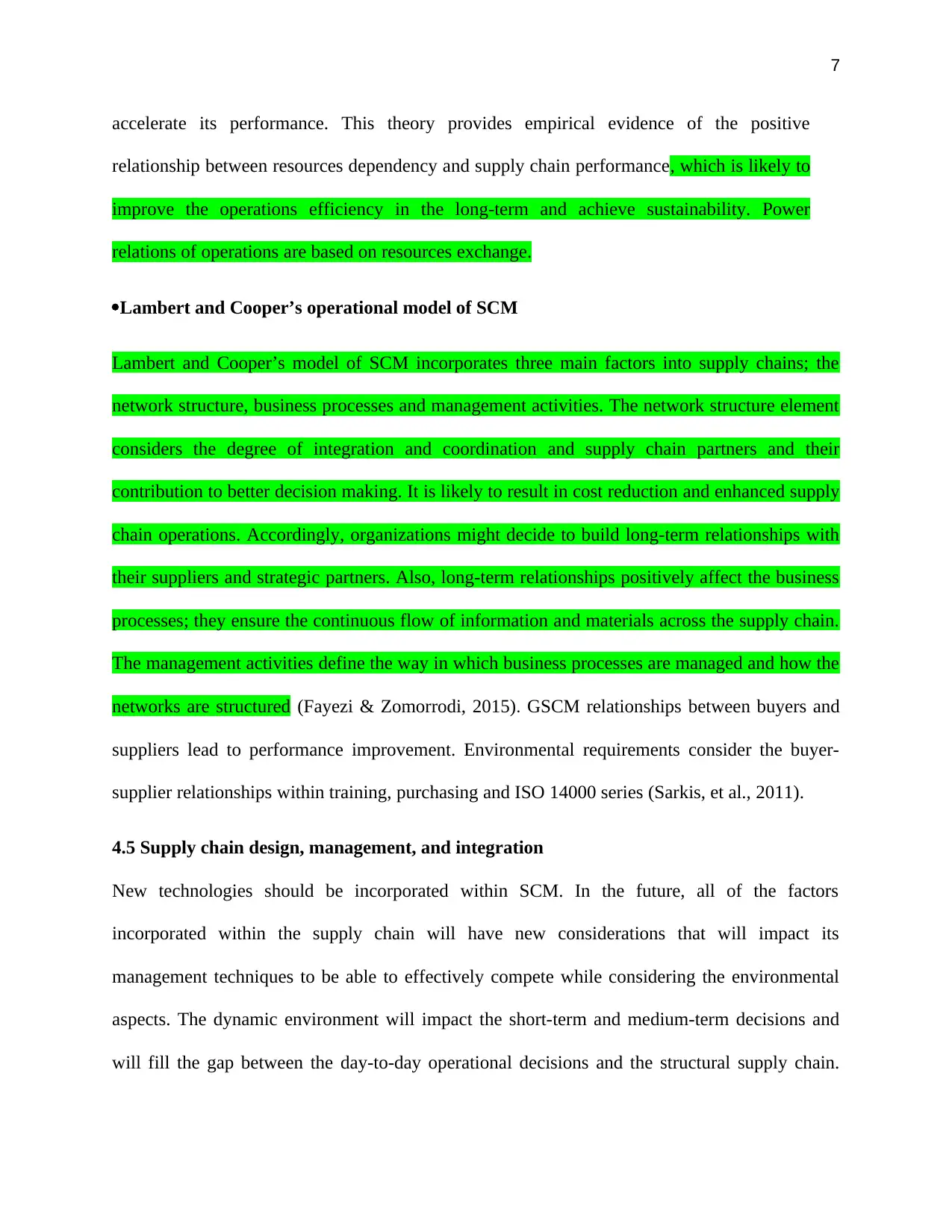
7
accelerate its performance. This theory provides empirical evidence of the positive
relationship between resources dependency and supply chain performance, which is likely to
improve the operations efficiency in the long-term and achieve sustainability. Power
relations of operations are based on resources exchange.
Lambert and Cooper’s operational model of SCM
Lambert and Cooper’s model of SCM incorporates three main factors into supply chains; the
network structure, business processes and management activities. The network structure element
considers the degree of integration and coordination and supply chain partners and their
contribution to better decision making. It is likely to result in cost reduction and enhanced supply
chain operations. Accordingly, organizations might decide to build long-term relationships with
their suppliers and strategic partners. Also, long-term relationships positively affect the business
processes; they ensure the continuous flow of information and materials across the supply chain.
The management activities define the way in which business processes are managed and how the
networks are structured (Fayezi & Zomorrodi, 2015). GSCM relationships between buyers and
suppliers lead to performance improvement. Environmental requirements consider the buyer-
supplier relationships within training, purchasing and ISO 14000 series (Sarkis, et al., 2011).
4.5 Supply chain design, management, and integration
New technologies should be incorporated within SCM. In the future, all of the factors
incorporated within the supply chain will have new considerations that will impact its
management techniques to be able to effectively compete while considering the environmental
aspects. The dynamic environment will impact the short-term and medium-term decisions and
will fill the gap between the day-to-day operational decisions and the structural supply chain.
accelerate its performance. This theory provides empirical evidence of the positive
relationship between resources dependency and supply chain performance, which is likely to
improve the operations efficiency in the long-term and achieve sustainability. Power
relations of operations are based on resources exchange.
Lambert and Cooper’s operational model of SCM
Lambert and Cooper’s model of SCM incorporates three main factors into supply chains; the
network structure, business processes and management activities. The network structure element
considers the degree of integration and coordination and supply chain partners and their
contribution to better decision making. It is likely to result in cost reduction and enhanced supply
chain operations. Accordingly, organizations might decide to build long-term relationships with
their suppliers and strategic partners. Also, long-term relationships positively affect the business
processes; they ensure the continuous flow of information and materials across the supply chain.
The management activities define the way in which business processes are managed and how the
networks are structured (Fayezi & Zomorrodi, 2015). GSCM relationships between buyers and
suppliers lead to performance improvement. Environmental requirements consider the buyer-
supplier relationships within training, purchasing and ISO 14000 series (Sarkis, et al., 2011).
4.5 Supply chain design, management, and integration
New technologies should be incorporated within SCM. In the future, all of the factors
incorporated within the supply chain will have new considerations that will impact its
management techniques to be able to effectively compete while considering the environmental
aspects. The dynamic environment will impact the short-term and medium-term decisions and
will fill the gap between the day-to-day operational decisions and the structural supply chain.
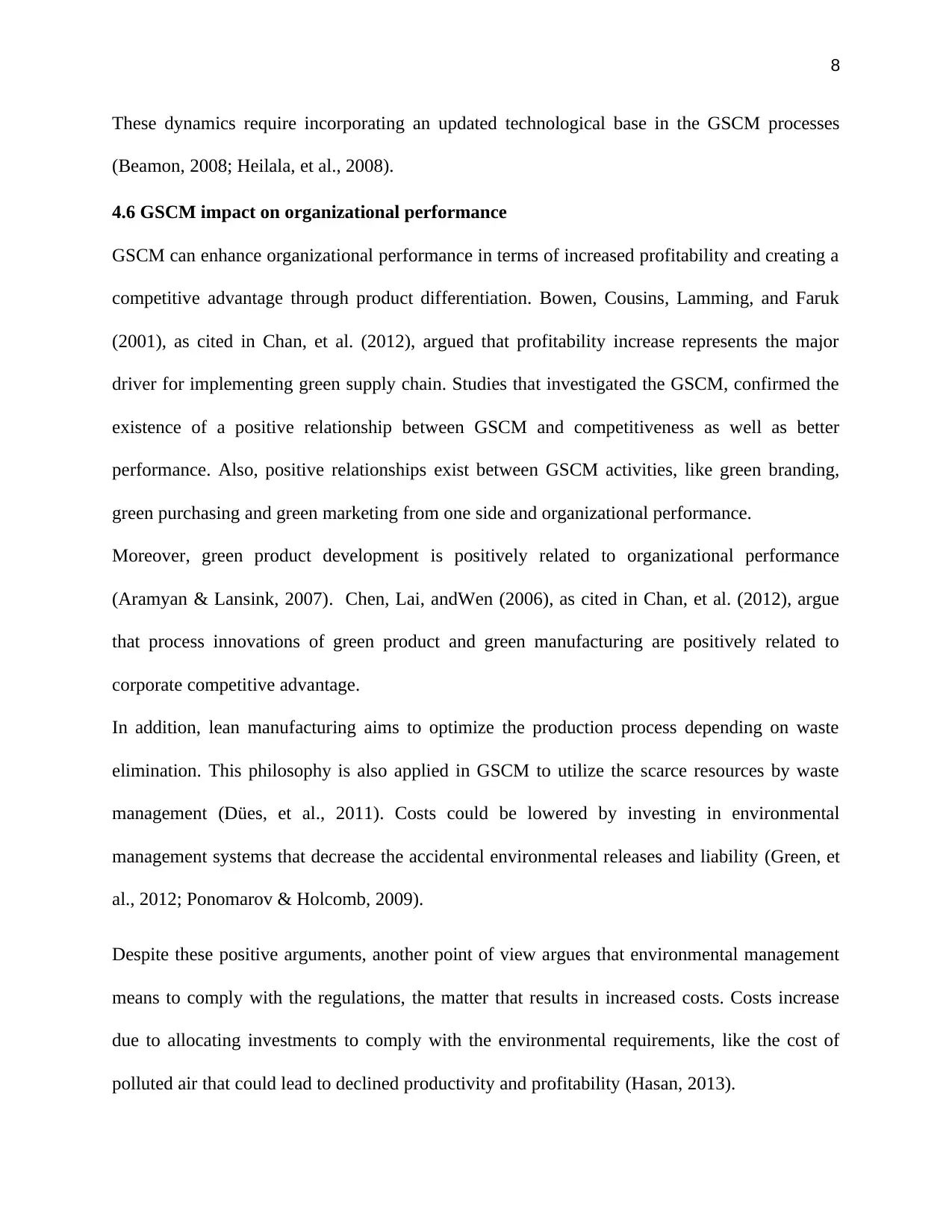
8
These dynamics require incorporating an updated technological base in the GSCM processes
(Beamon, 2008; Heilala, et al., 2008).
4.6 GSCM impact on organizational performance
GSCM can enhance organizational performance in terms of increased profitability and creating a
competitive advantage through product differentiation. Bowen, Cousins, Lamming, and Faruk
(2001), as cited in Chan, et al. (2012), argued that profitability increase represents the major
driver for implementing green supply chain. Studies that investigated the GSCM, confirmed the
existence of a positive relationship between GSCM and competitiveness as well as better
performance. Also, positive relationships exist between GSCM activities, like green branding,
green purchasing and green marketing from one side and organizational performance.
Moreover, green product development is positively related to organizational performance
(Aramyan & Lansink, 2007). Chen, Lai, andWen (2006), as cited in Chan, et al. (2012), argue
that process innovations of green product and green manufacturing are positively related to
corporate competitive advantage.
In addition, lean manufacturing aims to optimize the production process depending on waste
elimination. This philosophy is also applied in GSCM to utilize the scarce resources by waste
management (Dües, et al., 2011). Costs could be lowered by investing in environmental
management systems that decrease the accidental environmental releases and liability (Green, et
al., 2012; Ponomarov & Holcomb, 2009).
Despite these positive arguments, another point of view argues that environmental management
means to comply with the regulations, the matter that results in increased costs. Costs increase
due to allocating investments to comply with the environmental requirements, like the cost of
polluted air that could lead to declined productivity and profitability (Hasan, 2013).
These dynamics require incorporating an updated technological base in the GSCM processes
(Beamon, 2008; Heilala, et al., 2008).
4.6 GSCM impact on organizational performance
GSCM can enhance organizational performance in terms of increased profitability and creating a
competitive advantage through product differentiation. Bowen, Cousins, Lamming, and Faruk
(2001), as cited in Chan, et al. (2012), argued that profitability increase represents the major
driver for implementing green supply chain. Studies that investigated the GSCM, confirmed the
existence of a positive relationship between GSCM and competitiveness as well as better
performance. Also, positive relationships exist between GSCM activities, like green branding,
green purchasing and green marketing from one side and organizational performance.
Moreover, green product development is positively related to organizational performance
(Aramyan & Lansink, 2007). Chen, Lai, andWen (2006), as cited in Chan, et al. (2012), argue
that process innovations of green product and green manufacturing are positively related to
corporate competitive advantage.
In addition, lean manufacturing aims to optimize the production process depending on waste
elimination. This philosophy is also applied in GSCM to utilize the scarce resources by waste
management (Dües, et al., 2011). Costs could be lowered by investing in environmental
management systems that decrease the accidental environmental releases and liability (Green, et
al., 2012; Ponomarov & Holcomb, 2009).
Despite these positive arguments, another point of view argues that environmental management
means to comply with the regulations, the matter that results in increased costs. Costs increase
due to allocating investments to comply with the environmental requirements, like the cost of
polluted air that could lead to declined productivity and profitability (Hasan, 2013).
⊘ This is a preview!⊘
Do you want full access?
Subscribe today to unlock all pages.

Trusted by 1+ million students worldwide
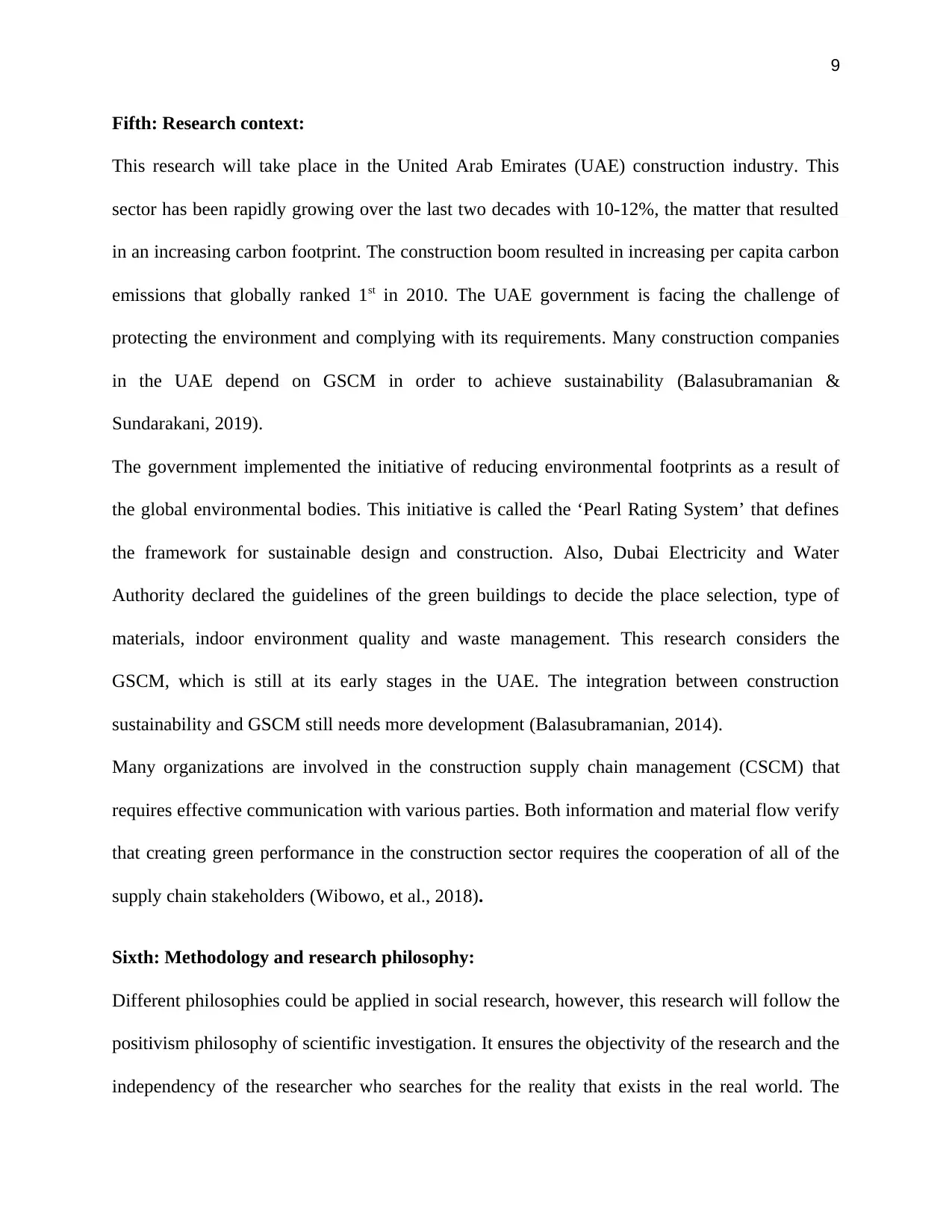
9
Fifth: Research context:
This research will take place in the United Arab Emirates (UAE) construction industry. This
sector has been rapidly growing over the last two decades with 10-12%, the matter that resulted
in an increasing carbon footprint. The construction boom resulted in increasing per capita carbon
emissions that globally ranked 1st in 2010. The UAE government is facing the challenge of
protecting the environment and complying with its requirements. Many construction companies
in the UAE depend on GSCM in order to achieve sustainability (Balasubramanian &
Sundarakani, 2019).
The government implemented the initiative of reducing environmental footprints as a result of
the global environmental bodies. This initiative is called the ‘Pearl Rating System’ that defines
the framework for sustainable design and construction. Also, Dubai Electricity and Water
Authority declared the guidelines of the green buildings to decide the place selection, type of
materials, indoor environment quality and waste management. This research considers the
GSCM, which is still at its early stages in the UAE. The integration between construction
sustainability and GSCM still needs more development (Balasubramanian, 2014).
Many organizations are involved in the construction supply chain management (CSCM) that
requires effective communication with various parties. Both information and material flow verify
that creating green performance in the construction sector requires the cooperation of all of the
supply chain stakeholders (Wibowo, et al., 2018).
Sixth: Methodology and research philosophy:
Different philosophies could be applied in social research, however, this research will follow the
positivism philosophy of scientific investigation. It ensures the objectivity of the research and the
independency of the researcher who searches for the reality that exists in the real world. The
Fifth: Research context:
This research will take place in the United Arab Emirates (UAE) construction industry. This
sector has been rapidly growing over the last two decades with 10-12%, the matter that resulted
in an increasing carbon footprint. The construction boom resulted in increasing per capita carbon
emissions that globally ranked 1st in 2010. The UAE government is facing the challenge of
protecting the environment and complying with its requirements. Many construction companies
in the UAE depend on GSCM in order to achieve sustainability (Balasubramanian &
Sundarakani, 2019).
The government implemented the initiative of reducing environmental footprints as a result of
the global environmental bodies. This initiative is called the ‘Pearl Rating System’ that defines
the framework for sustainable design and construction. Also, Dubai Electricity and Water
Authority declared the guidelines of the green buildings to decide the place selection, type of
materials, indoor environment quality and waste management. This research considers the
GSCM, which is still at its early stages in the UAE. The integration between construction
sustainability and GSCM still needs more development (Balasubramanian, 2014).
Many organizations are involved in the construction supply chain management (CSCM) that
requires effective communication with various parties. Both information and material flow verify
that creating green performance in the construction sector requires the cooperation of all of the
supply chain stakeholders (Wibowo, et al., 2018).
Sixth: Methodology and research philosophy:
Different philosophies could be applied in social research, however, this research will follow the
positivism philosophy of scientific investigation. It ensures the objectivity of the research and the
independency of the researcher who searches for the reality that exists in the real world. The
Paraphrase This Document
Need a fresh take? Get an instant paraphrase of this document with our AI Paraphraser
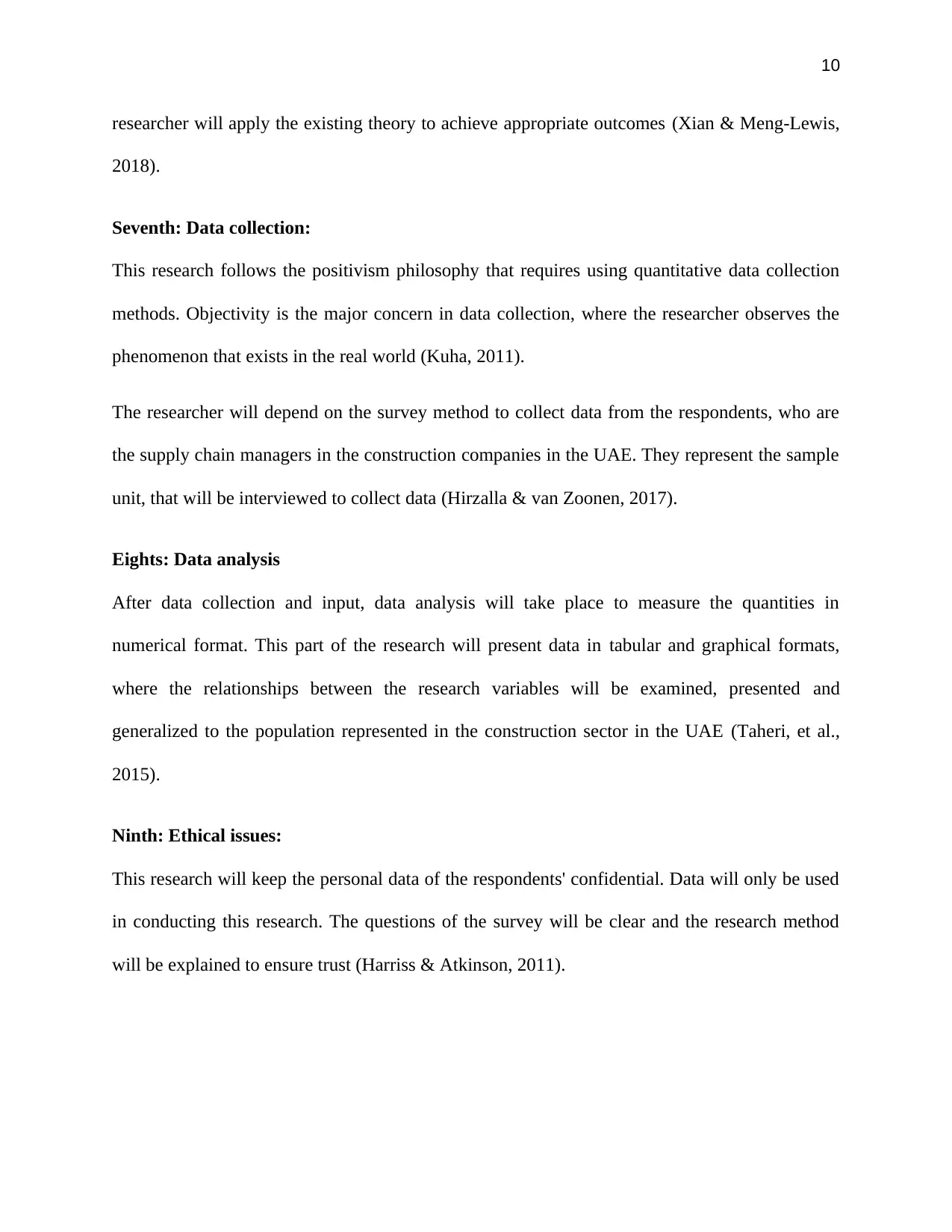
10
researcher will apply the existing theory to achieve appropriate outcomes (Xian & Meng-Lewis,
2018).
Seventh: Data collection:
This research follows the positivism philosophy that requires using quantitative data collection
methods. Objectivity is the major concern in data collection, where the researcher observes the
phenomenon that exists in the real world (Kuha, 2011).
The researcher will depend on the survey method to collect data from the respondents, who are
the supply chain managers in the construction companies in the UAE. They represent the sample
unit, that will be interviewed to collect data (Hirzalla & van Zoonen, 2017).
Eights: Data analysis
After data collection and input, data analysis will take place to measure the quantities in
numerical format. This part of the research will present data in tabular and graphical formats,
where the relationships between the research variables will be examined, presented and
generalized to the population represented in the construction sector in the UAE (Taheri, et al.,
2015).
Ninth: Ethical issues:
This research will keep the personal data of the respondents' confidential. Data will only be used
in conducting this research. The questions of the survey will be clear and the research method
will be explained to ensure trust (Harriss & Atkinson, 2011).
researcher will apply the existing theory to achieve appropriate outcomes (Xian & Meng-Lewis,
2018).
Seventh: Data collection:
This research follows the positivism philosophy that requires using quantitative data collection
methods. Objectivity is the major concern in data collection, where the researcher observes the
phenomenon that exists in the real world (Kuha, 2011).
The researcher will depend on the survey method to collect data from the respondents, who are
the supply chain managers in the construction companies in the UAE. They represent the sample
unit, that will be interviewed to collect data (Hirzalla & van Zoonen, 2017).
Eights: Data analysis
After data collection and input, data analysis will take place to measure the quantities in
numerical format. This part of the research will present data in tabular and graphical formats,
where the relationships between the research variables will be examined, presented and
generalized to the population represented in the construction sector in the UAE (Taheri, et al.,
2015).
Ninth: Ethical issues:
This research will keep the personal data of the respondents' confidential. Data will only be used
in conducting this research. The questions of the survey will be clear and the research method
will be explained to ensure trust (Harriss & Atkinson, 2011).
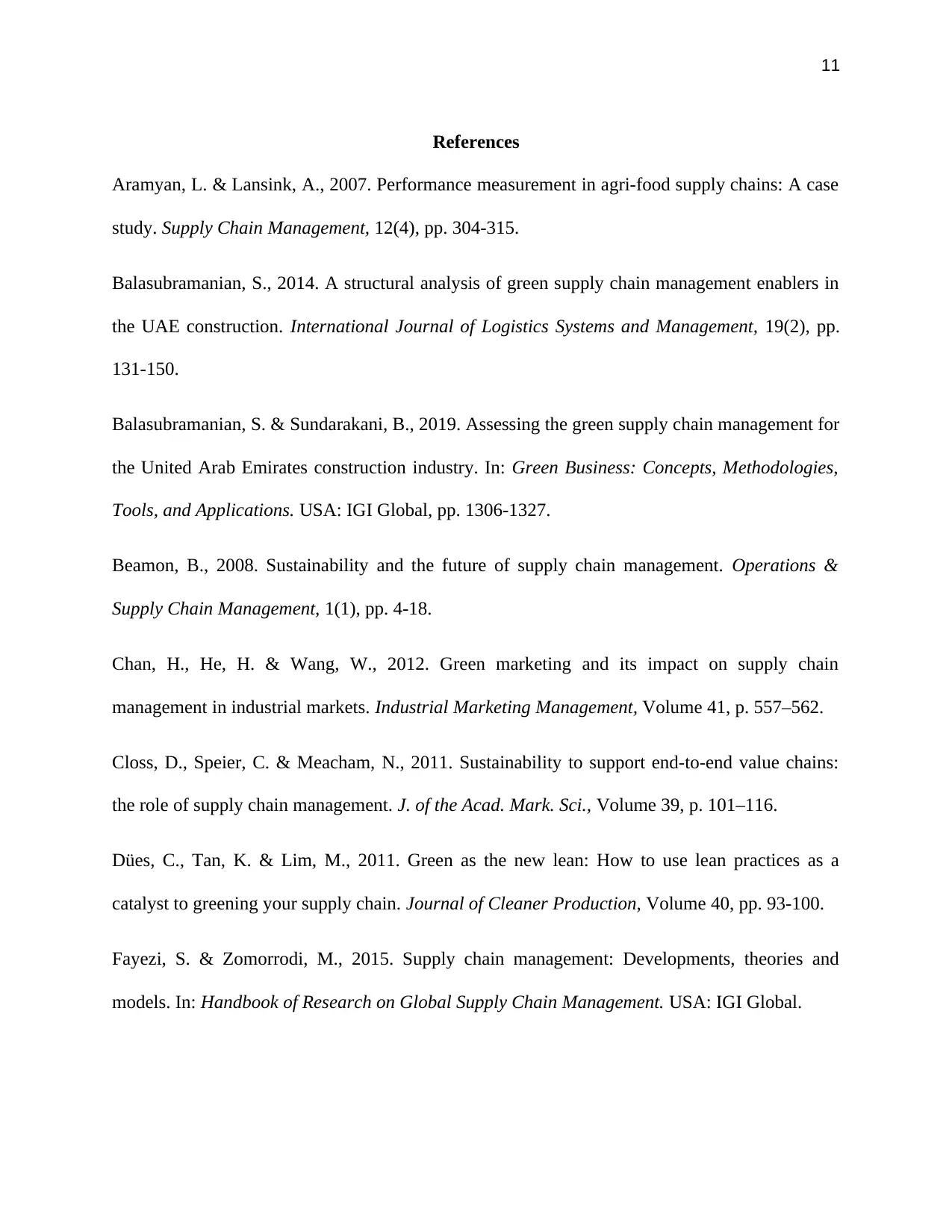
11
References
Aramyan, L. & Lansink, A., 2007. Performance measurement in agri-food supply chains: A case
study. Supply Chain Management, 12(4), pp. 304-315.
Balasubramanian, S., 2014. A structural analysis of green supply chain management enablers in
the UAE construction. International Journal of Logistics Systems and Management, 19(2), pp.
131-150.
Balasubramanian, S. & Sundarakani, B., 2019. Assessing the green supply chain management for
the United Arab Emirates construction industry. In: Green Business: Concepts, Methodologies,
Tools, and Applications. USA: IGI Global, pp. 1306-1327.
Beamon, B., 2008. Sustainability and the future of supply chain management. Operations &
Supply Chain Management, 1(1), pp. 4-18.
Chan, H., He, H. & Wang, W., 2012. Green marketing and its impact on supply chain
management in industrial markets. Industrial Marketing Management, Volume 41, p. 557–562.
Closs, D., Speier, C. & Meacham, N., 2011. Sustainability to support end-to-end value chains:
the role of supply chain management. J. of the Acad. Mark. Sci., Volume 39, p. 101–116.
Dües, C., Tan, K. & Lim, M., 2011. Green as the new lean: How to use lean practices as a
catalyst to greening your supply chain. Journal of Cleaner Production, Volume 40, pp. 93-100.
Fayezi, S. & Zomorrodi, M., 2015. Supply chain management: Developments, theories and
models. In: Handbook of Research on Global Supply Chain Management. USA: IGI Global.
References
Aramyan, L. & Lansink, A., 2007. Performance measurement in agri-food supply chains: A case
study. Supply Chain Management, 12(4), pp. 304-315.
Balasubramanian, S., 2014. A structural analysis of green supply chain management enablers in
the UAE construction. International Journal of Logistics Systems and Management, 19(2), pp.
131-150.
Balasubramanian, S. & Sundarakani, B., 2019. Assessing the green supply chain management for
the United Arab Emirates construction industry. In: Green Business: Concepts, Methodologies,
Tools, and Applications. USA: IGI Global, pp. 1306-1327.
Beamon, B., 2008. Sustainability and the future of supply chain management. Operations &
Supply Chain Management, 1(1), pp. 4-18.
Chan, H., He, H. & Wang, W., 2012. Green marketing and its impact on supply chain
management in industrial markets. Industrial Marketing Management, Volume 41, p. 557–562.
Closs, D., Speier, C. & Meacham, N., 2011. Sustainability to support end-to-end value chains:
the role of supply chain management. J. of the Acad. Mark. Sci., Volume 39, p. 101–116.
Dües, C., Tan, K. & Lim, M., 2011. Green as the new lean: How to use lean practices as a
catalyst to greening your supply chain. Journal of Cleaner Production, Volume 40, pp. 93-100.
Fayezi, S. & Zomorrodi, M., 2015. Supply chain management: Developments, theories and
models. In: Handbook of Research on Global Supply Chain Management. USA: IGI Global.
⊘ This is a preview!⊘
Do you want full access?
Subscribe today to unlock all pages.

Trusted by 1+ million students worldwide
1 out of 15
Related Documents
Your All-in-One AI-Powered Toolkit for Academic Success.
+13062052269
info@desklib.com
Available 24*7 on WhatsApp / Email
![[object Object]](/_next/static/media/star-bottom.7253800d.svg)
Unlock your academic potential
Copyright © 2020–2025 A2Z Services. All Rights Reserved. Developed and managed by ZUCOL.




